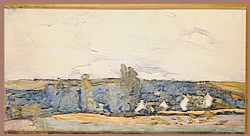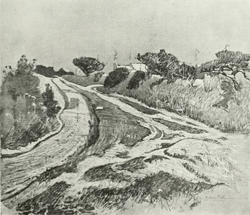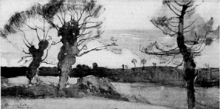Florence Esté
Florence Esté (1860 – April 25, 1926) was an American painter in oils born in Cincinnati, Ohio.[1] She also worked in watercolors, pastels, and as an etcher and engraver. She was particularly well known for her landscapes, which were said to have been influenced by Japanese artworks[2] and were noted for their "harmony of color".[3] Her obituary in the New York Times referred to her as "one of the best known women landscape painters."[4]
Florence Esté | |
|---|---|
| Born | 1860 Cincinnati, Ohio |
| Died | April 25, 1926 (aged 65–66) Paris, France |
| Nationality | American |
| Occupation | Painter |


Education and career
In 1874, a teenage Esté traveled to France with Emily Sartain, studying with Tony Robert-Fleury[5] and working in the comrade d'atelier of Emily Sartain and Jeanne Rongier.[6][7]
Between 1876 and 1882, she studied with Thomas Eakins at the Pennsylvania Academy of the Fine Arts.[8] Around 1886–1887, she, her friend Cecilia Beaux and other young women artists such as Dora Brown and Julia Foote studied with William Sartain in private art classes at the Philadelphia School of Design for Women where his sister Emily Sartain was principal.[5][9][10]
In 1884, Esté learned to etch on the press of Stephen Parrish. Parrish and fellow etcher Stephen Ferris were enrolled in the men's life class at the Pennsylvania Academy. A number of the women at the Academy became significant in the American etching revival, including Esté, Gabrielle Clements, Blanche Dillaye, Margaret Lesley, Margaret Levin, and Mary Franklin.[5]
Florence Esté moved permanently to France in 1888.[11] In Paris she enrolled at the Academie Colarossi[6] and studied with Alexander Nozal (1852–1929) and Raphael Collin (1850–1916).[5] She remained in France during the first world war. Her compatriot Elizabeth Nourse reported in 1915 that "Florence Esté is painting again in Paris after an exciting summer, for the village where she was working had to be evacuated at the approach of the enemy."[11]
She became a member of the Société Nationale des Beaux-Arts in France around 1909 and exhibited at the Paris salons.[12][13] Her painting Un Bourg breton (A Breton village) was purchased by the French government in 1918. Her painting La Vallée (The Valley) was purchased by the State in 1921.[14] Some of her paintings were hung in the Luxembourg Gallery in Paris.[4]
She was also an honorary member of the Philadelphia Water Color Club,[5] and continued to exhibit in America at the Annual Philadelphia Watercolour Exhibition,[15][16] the Art Institute of Chicago and the Pennsylvania Academy of Fine Arts.[17][18] Her watercolors won the PAFA prize in 1925.[19]
Armory Show of 1913

The 1913 Armory Show featured the American Association of Painters and Sculptors (AAPS), and was one of the first exhibitions of "new art" or modern art. Fifty women participated as artists and donors in this revolutionary show, making up one sixth of the contributions. These women can be considered significant leaders, forging the beginnings of the feminist art movement.[20]
Esté exhibited two of her watercolors, The Village (variously $500 or $200) and The First Snow($300) at the 1913 Armory Show.[21][22] The First Snow was previously shown in the Philadelphia Water-Color Exhibition, where it was received the following review: "An interesting picture, almost in monotone, by Miss Florence Esté, entitled The First Snow, was most effective in the simplicity of the medium on a tinted background."[23]
Personal life
Among Esté's good friends included fellow students from the Pennsylvania Academy, Elizabeth MacDowell, Alice Barber Stephens, Mary K. Trotter, and Gabrielle D. Clements.[24]
Sources

- Clark, Edna Maria (1975). Ohio art and artists. Detroit: Gale Research. ISBN 978-0810340589.
- Peet, Phyllis (1988). American women of the etching revival : February 9 – May 9, 1988, High Museum of Art, Atlanta, Georgia. Atlanta, Ga.: The Museum. ISBN 978-0939802456.
- "Obituary", American Art Annual, vol. 4. Washington, D. C.: American Federation of Arts, 1926.
References
- Petteys, Chris (1985). Dictionary of women artists : an international dictionary of women artists born before 1900 (5 ed.). Boston, Mass.: G.K. Hall. ISBN 978-0816184569.
- "Studio-Talk". International Studio. 36: 151. 1909. Retrieved 3 February 2014.
- "Clipping from The Times". New York Times. 15 January 1900. Retrieved 3 February 2014.
- "Miss Este, Painter, Dies.; American Landscape Artist Represented in Luxembourg Gallery". New York Times. April 27, 1926. Retrieved 29 April 2014.
- Falk, Peter Hastings (1999). Who was who in American art, 1564–1975 : 400 years of artists in America. Madison, CT: Sound View Press. p. 1060. ISBN 978-0-932087-55-3.
- "Florence Este (1860–1926)". Ask/Art. Retrieved 1 February 2014.
- Swinth, Kirsten (2001). Painting professionals : women artists and the development of modern American art, 1870–1930. Chapel Hill, N.C.: University of North Carolina Press. ISBN 978-0807826423.
- Tappert, Tara Leigh. "OUT OF THE BACKGROUND: CECILIA BEAUX AND THE ART OF PORTRAITURE". Resource Library. Retrieved 3 February 2014.
- Martinez, Katharine; Talbott, Page, eds. (2000). Philadelphia's cultural landscape : the Sartain family legacy. Philadelphia, Pa.: Temple Univ. Press. ISBN 978-1566397919.
- Ackerman, Gerald M. (1994). American orientalists. Courbevoie: ACR. p. 191. ISBN 978-2867700781.
- Nourse, Elizabeth (March 1915). "More pages from the Journal of an American Artist in Paris". Art and Progress. American Federation of Arts. 6. Retrieved 3 February 2014.
- "American Pictures to Excel This Year; Those Being Made Ready for Paris Salons Are of Exceptional Merit. FRIESEKE TO SHOW NUDES Florence Este Will Exhibit a Large Canvas – Study in Blues by Tanner – Other Works". New York Times. 1910-02-26. Retrieved 1 February 2014.
- "Bourdelle Group is Salon's Sensation". American Art News. 19 (30): 1–10. 7 May 1921. JSTOR 25589808.
- "Works by United States artists from the French National Collexctions". La Fayette Database of American Art. Retrieved 3 February 2014.
- "Water Colors and Other Works: Shown in the Philadelphia Water Color Club's Annual Exhibition". Art and Progress. 5 (3): 86. January 1914. JSTOR 20561049.
- "Studio Talk". The Studio: An Illustrated Magazine of Fine and Applied Art. 55 (227): 237. 1912-02-15. Retrieved 3 February 2014.
- Henderson, Helen W. (March 1905). "Centenary Exhibition of the Pennsylvania Academy of the Fine Arts". Brush and Pen. 15 (3): 163. JSTOR 25503798.
- Bush, E. T. (March 1906). "A Notable Exhibition at the Pennsylvania Academy". Brush and Pen. XVII (3): 93–126. JSTOR 25503967.
- Opitz, edited by Glenn B. (1986). Mantle Fielding's dictionary of American painters, sculptors & engravers (2nd newly-rev., enl., and updated ed.). Poughkeepsie, NY: Apollo. p. 264. ISBN 978-0938290049.CS1 maint: extra text: authors list (link)
- Goonewardena, Apeksha. "An Indelible History". Found in Collection. Retrieved 1 November 2013.
- Brown, Milton W., The Story of the Armory Show, The Joseph H. Hirshhorn Foundation, 1963, p. 242
- "1913 Armory Show List by Gallery". New York Historical Society. Retrieved 1 February 2014.
- Holme, Charles (1912). "The International studio". 46. Retrieved 3 June 2014. Cite journal requires
|journal=(help) - "Florence Este's Valid Opinions". The Philadelphia Inquirer. January 20, 1924. p. 31. Retrieved March 30, 2017 – via newspapers.com.